Discover the ultimate list of books for engineers. Explore classics to modern gems to expand your engineering knowledge.
As a member of the Special Science Class in high school, I had to study physics and mathematics in-depth. I admit — it’s not something I thoroughly enjoyed. But my classmates who showed genuine interest in it have always fascinated me. Being a student is a unique experience; read our round-up of articles about being a student for personal insights.
Many of my old schoolmates are now engineers. Whenever we meet, they talk about things laymen like me don’t understand. But I know one thing: Engineering uses math and science to solve problems. Our houses, airplanes, computers — we are surrounded by inventions that were just once ideas. With engineers’ skills and brainpower, society gets to enjoy a more comfortable life.
Contents
- 1. Structures: Or Why Things Don’t Fall Down by J.E. Gordon
- 2. The Existential Pleasures of Engineering by Samuel C. Florman
- 3. To Engineer Is Human: The Role of Failure in Successful Design by Henry Petroski
- 4. Thing Explainer: Complicated Stuff in Simple Words by Randall Munroe
- 5. The Art of Doing Science and Engineering: Learning to Learn by Richard Hamming
- 6. Engineer to Win by Carroll Smith
- 7. The Design Of Everyday Things by Don Norman
- 8. Elon Musk: Tesla, SpaceX, and the Quest for a Fantastic Future by Ashlee Vance
- 9. Shigley’s Mechanical Engineering Design by Richard Budynas and Keith Nisbett
- 10. Clean Code: A Handbook of Agile Software Craftsmanship by Robert C. Martin
- 11. Engineering Mathematics and Artificial Intelligence Foundations, Methods, and Applications by Herb Kunze et al.
- 12. Skunk Works: A Personal Memoir of My Years at Lockheed by Ben R. Rich
1. Structures: Or Why Things Don’t Fall Down by J.E. Gordon

In Structures: Or Why Things Don’t Fall Down, J.E. Gordon does what he does best: explains the whys of complex engineering with informal, easy-to-grasp analysis. He uses humor and the natural world to unravel technical terms that nonexperts won’t understand otherwise. It’s a comprehensive book that covers a wide range of topics, including those on the ground, in the sky, and in between.
He takes the readers through an exciting journey by tackling questions we have asked at least once in our lifetime. These questions may be, “How can that bridge not fold under all that weight?” or “How can skyscrapers stay up?” Gordon effectively uses biology and other industries to explain engineering concepts. Read it on Amazon; click here.
“Mathematics is to the scientist and the engineer a tool, to the professional mathematician a religion, but to the ordinary person a stumbling block.”
J.E. Gordon, Structures: Or Why Things Don’t Fall Down
2. The Existential Pleasures of Engineering by Samuel C. Florman
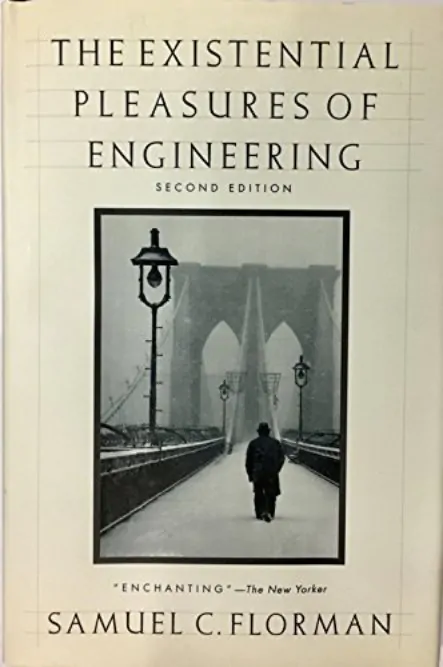
The Existential Pleasures of Engineering, penned by a New York-based civil engineer, delves into the intricate world of modern-day engineers. It sheds light on their unique mindset and emotional connection to their profession. By exploring these aspects, this book transcends the realm of physical engineering and resonates with anyone engaged in technology.
This insightful work provides a deep understanding of the existential joys and challenges of engineering. It interprets the creative and philosophical aspects that define this profession in the contemporary world. Read it on Amazon; click here.
“My proposition is that the nature of engineering has been misconceived. Analysis, rationality, materialism, and practical creativity do not preclude emotional fulfillment; they are pathways to such fulfillment.”
Samuel C. Florman, The Existential Pleasures of Engineering
3. To Engineer Is Human: The Role of Failure in Successful Design by Henry Petroski
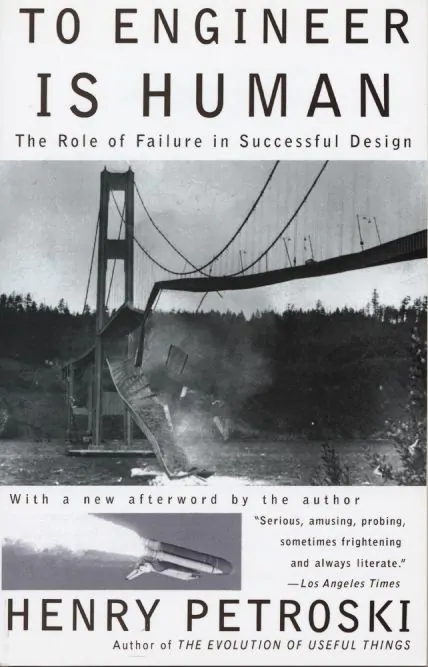
To Engineer Is Human: The Role of Failure in Successful Design is a thought-provoking exploration of the complex relationship between engineering successes and failures. Through compelling case studies, Petroski offers readers a glimpse into the engineering world, where innovation and progress often materialize from the ashes of failure.
Petroski boldly presents engineering failures like the Kansas City Hyatt Regency Hotel collapse and the Tacoma Narrows Bridge. He does this to prove that engineering is not an infallible discipline. Instead, it’s an inherently human endeavor marked by trial and error. It reminds us that setbacks are stepping stones toward the most successful engineering feats. Read it on Amazon; click here.
“A good judgment is usually the result of experience. And experience is frequently the result of bad judgment. But to learn from the experience of others requires those who have the experience to share the knowledge with those who follow.”
Henry Petroski, To Engineer Is Human: The Role of Failure in Successful Design
4. Thing Explainer: Complicated Stuff in Simple Words by Randall Munroe

Thing Explainer: Complicated Stuff in Simple Words is a fun journey into complex machinery and technology explained using the simplest words. Munroe’s book breaks down intricate jargon and elucidates how machines work with an approach anyone can understand.
One of the book’s remarkable features is its potential to be a reference book, especially for kids interested in physics and engineering. After all, engineering is physics applied to create practical solutions. Readers then get a chance to be competent in many subjects. This includes the inner workings of ordinary objects we use daily to the astronauts’ space explorations. Read it on Amazon; click here.
“By choosing the right words, you can take an idea that’s happening in your head and try to make an idea like it happens in someone else’s.”
Randall Munroe, Thing Explainer: Complicated Stuff in Simple Words
If you’re looking for something to spark your children’s imagination, see the best books for eight-year-olds.
5. The Art of Doing Science and Engineering: Learning to Learn by Richard Hamming
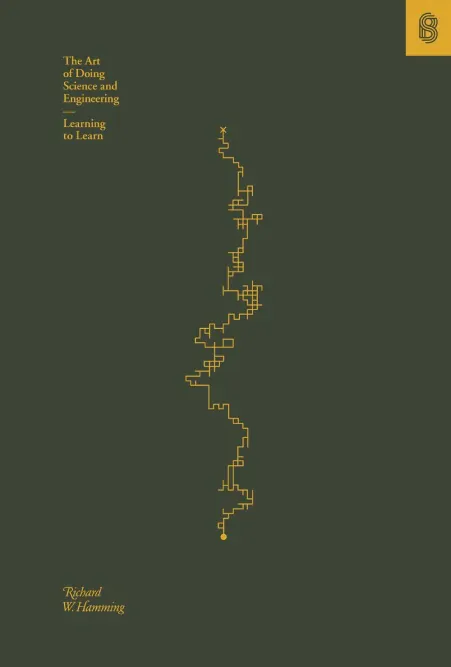
The Art of Doing Science and Engineering: Learning to Learn by Richard Hamming, a renowned mathematician, explores the thought processes behind the birth of groundbreaking ideas. Beyond offering technical knowledge, the book encourages readers to reflect on the world around them. Hamming highlights the importance of having a mindset that values curiosity and critical thinking.
Here, Hamming shares his learning process that pushes the boundaries of academia. The book delves into the works of giants. Think Claude Shannon’s information theory, Albert Einstein’s theory of relativity, and Grace Hopper’s pioneering work on error-correcting codes. It provides practical insights and anecdotes that clarify the creative and problem-solving procedures behind these transformative ideas. It’s a must-have resource for anyone in the engineering or STEM fields. Read it on Amazon; click here.
“Education is what, when, and why to do things. Training is how to do it.”
Richard Hamming, The Art of Doing Science and Engineering: Learning to Learn
6. Engineer to Win by Carroll Smith

Engineer to Win is a treasure trove of knowledge delving into the intricate world of racing cars. It covers various topics, including metal fatigue, ground effects, and other essential tools. You’ll want it on your bookshelf if you’re a racing enthusiast.
It has extensive coverage of metallurgy. For instance, it recognizes the characteristics of metals across different industries and grades. This makes it a prized book for understanding how materials behave under extreme conditions. Beyond its technical depth, the book’s charm lies in its knack for making ostensibly dry material and subjects enjoyable. Smith shares high-end information that is not readily available to the public, offering a behind-the-scenes look at the secrets of racing technology. Read it on Amazon; click here.
“Parts do not break — we break them.”
Carroll Smith, Engineer to Win
7. The Design Of Everyday Things by Don Norman

The Design Of Everyday Things underscores the intersection between design, human psychology, and functionality in the objects that we use in everyday life. Norman’s book is about human-centered design and the importance of crafting products and systems with the user’s experience and needs at the forefront.
In the book, he argues that technological advancements are constant. But Norman reminds us that change should always be rooted in improving usability and practicality. Modernization should simplify our lives, not complicate them. At its essence, The Design of Everyday Things imparts fundamental principles for creating meaningful designs that stand the test of time. Read it on Amazon; click here.
“Experience is critical, for it determines how fondly people remember their interactions.”
Don Norman, The Design Of Everyday Things
8. Elon Musk: Tesla, SpaceX, and the Quest for a Fantastic Future by Ashlee Vance
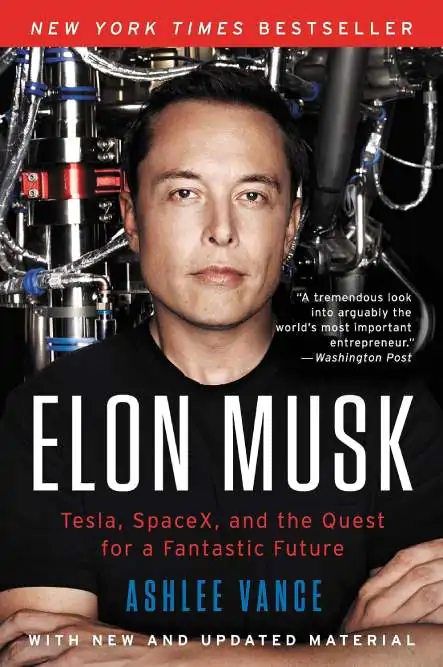
Elon Musk: Tesla, SpaceX, and the Quest for a Fantastic Future dives into the life and efforts of one of the most talked-about visionaries of the 21st century. His tale as a South African boy dedicated to learning code to becoming a tech mogul has thrown many industries into uproar.
Despite not having a formal engineering degree, Musk possesses the quintessential engineering mindset. He sees problems as challenges to be solved and is unafraid to venture into uncharted territories. This book offers a fast-paced narrative of Elon Musk’s audacious but successful thinking. Read it on Amazon; click here.
“One thing that Musk holds in the highest regard is resolve, and he respects people who continue on after being told no.”
Ashlee Vance, Elon Musk: Tesla, SpaceX, and the Quest for a Fantastic Future
9. Shigley’s Mechanical Engineering Design by Richard Budynas and Keith Nisbett
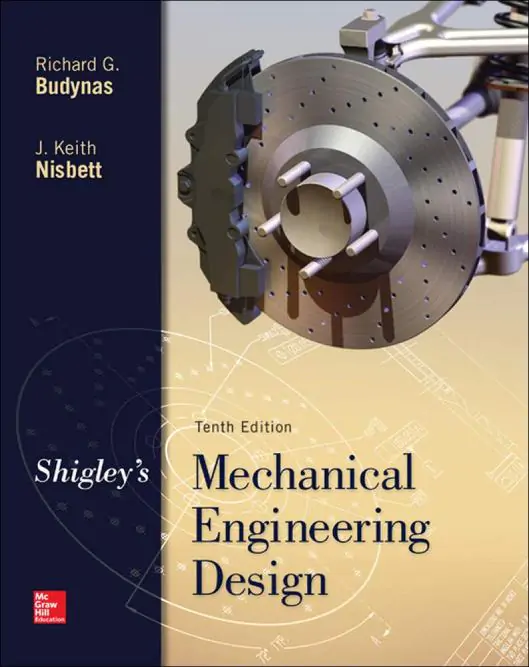
Shigley’s Mechanical Engineering Design is an essential companion for undergraduate mechanical engineering students. Still, its value extends beyond the classroom to professionals seeking to revisit and reinforce their foundational knowledge.
The book bridges the gap between fundamental engineering concepts and their practical application. It even covers specialized areas, such as failure prevention and analysis tools. These topics are critical for anyone involved in mechanical engineering, as they directly impact the reliability and safety of mechanical systems. Read it on Amazon; click here.
“Engineers use science to solve their problems if the science is available. But available or not, the problem must be solved, and whatever form the solution takes under these conditions is called engineering.”
Richard Budynas and Keith Nisbett, Shigley’s Mechanical Engineering Design
10. Clean Code: A Handbook of Agile Software Craftsmanship by Robert C. Martin

Robert C. Martin offers his pivotal work via the comprehensive guide Clean Code: A Handbook of Agile Software Craftsmanship. It doesn’t only instill fundamentals of what makes a code “clean” through principles, design patterns, and best practices. It also provides case studies of increasing complexity. Through these exercises, students can practice what they’ve learned.
This practical approach equips developers with the skills and insights to differentiate between good and bad code. More importantly, it teaches how to transform bad code into something that’s not only functional but also a joy to work on. Clean Code extends its value beyond individual developers. This makes it a must-read for the entire spectrum of software professionals, from developers to architects. Read it on Amazon; click here.
“Functions should either do something or answer something, but not both.”
Robert C. Martin, Clean Code: A Handbook of Agile Software Craftsmanship
11. Engineering Mathematics and Artificial Intelligence Foundations, Methods, and Applications by Herb Kunze et al.
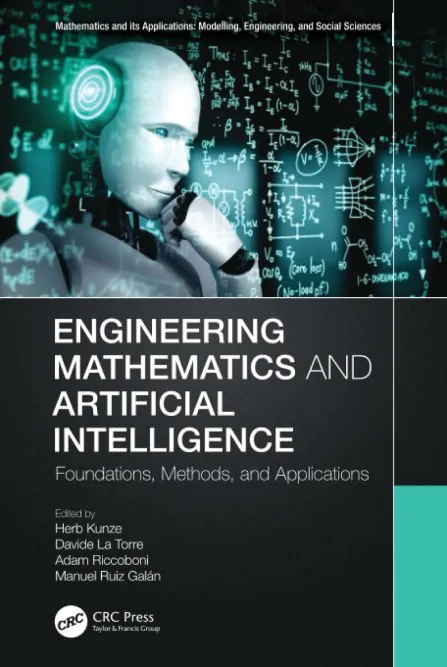
To keep up with the ever-evolving field of Artificial Intelligence and Machine learning, the authors come up with Engineering Mathematics and Artificial Intelligence Foundations, Methods, and Applications. It centers around the growth and changes in AI/ML and how mathematics and algorithms play a part in these industries.
The book involves the most updated research on the subject. It’s a practical guide on how current systems can be enhanced and optimized by applying mathematics and the latest AI technologies. Read it on Amazon; click here.
“The fields of Artificial Intelligence (AI) and Machine Learning (ML) have grown dramatically in recent years, with an increasingly impressive spectrum of successful applications.”
Herb Kunze et al., Engineering Mathematics and Artificial Intelligence Foundations, Methods, and Applications
12. Skunk Works: A Personal Memoir of My Years at Lockheed by Ben R. Rich

Skunk Works: A Personal Memoir of My Years at Lockheed is an adrenaline-inducing account of the world of aerospace engineering and the evolution of aeronautical warfare. It’s a rare glimpse into the mind of a true innovator. One who led the creation of iconic aircraft like the SR-71 Blackbird and the U-2.
Rich didn’t just recount his history at the Lockheed Martin Skunk Works division. He immerses readers in the high-stakes world of covert aerospace development. The memoir presents the author’s anecdotes and those from CIA and Air Force pilots who participated in these real-world risky missions. It’s literature to satiate those enchanted by aerodynamics, military aviation, and defense technology. Read it on Amazon; click here.
“The rule of thumb in the aerospace business was the more you build, the better you get at it.”
Ben R. Rich Skunk Works: A Personal Memoir of My Years at Lockheed
Looking for more? Check out our round-up of the best books for computer science!